How do you control your editing application? Regardless of whether you are editing Avid, Final Cut, Premiere, Resolve, or even Vegas, you are basically trying to communicate with a piece of software, to get it to very precisely alter a group of video clips. The more efficiently you can get the ideas from your mind into the software, the better time you are going to have editing your project. The primary way that most people communicate with a computer is through the mouse and keyboard. The mouse has analog input in the form of motion and scroll wheel, and digital input from the buttons, while keyboards offer a wide selection of digital options through its numerous labeled keys.
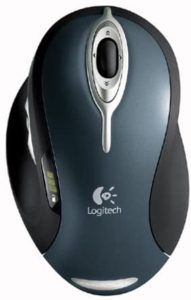 There are a number of ways that this human to machine interface can be improved on. The first is through keyboard improvements, either by better labeling the keys with what other functions have been assigned to them in a given application, or by adding customizable keys. Many editing environments are relatively dark, so backlit keyboards could be beneficial as well. Mice can also be improved by adding a scroll wheel for a third axis of analog control, and by adding buttons in various places. I use Logitech mice with a variety of features that help me edit. I just recently replaced my G602 with a new G604, with added back the scroll wheel side click left and right, which I map to previous and next cut. My all time favorite was the MX 1000, which had a rocker around the scroll wheel that lent itself to zoom in and out of the timeline, which I now map to the + and – buttons on my G604.
There are a number of ways that this human to machine interface can be improved on. The first is through keyboard improvements, either by better labeling the keys with what other functions have been assigned to them in a given application, or by adding customizable keys. Many editing environments are relatively dark, so backlit keyboards could be beneficial as well. Mice can also be improved by adding a scroll wheel for a third axis of analog control, and by adding buttons in various places. I use Logitech mice with a variety of features that help me edit. I just recently replaced my G602 with a new G604, with added back the scroll wheel side click left and right, which I map to previous and next cut. My all time favorite was the MX 1000, which had a rocker around the scroll wheel that lent itself to zoom in and out of the timeline, which I now map to the + and – buttons on my G604. 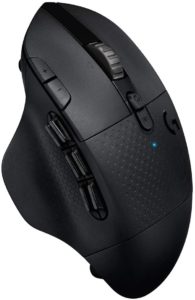 There are also six buttons on the side, which I think begins to be too many for effectively finding them by feel, but I map functions like Enable/Disable clip, C, V, and modifiers like CTRL, ALT, and SHIFT to them. Mapping Spacebar to one makes my mouse into a wireless remote for playback control, when I sit at the couch and watch the NLE output on my TV. So I think a good mouse is probably the best interface investment you can make, with customizable tactile controls that you can feel and memorize, but there are other options for improving efficiency beyond that.
There are also six buttons on the side, which I think begins to be too many for effectively finding them by feel, but I map functions like Enable/Disable clip, C, V, and modifiers like CTRL, ALT, and SHIFT to them. Mapping Spacebar to one makes my mouse into a wireless remote for playback control, when I sit at the couch and watch the NLE output on my TV. So I think a good mouse is probably the best interface investment you can make, with customizable tactile controls that you can feel and memorize, but there are other options for improving efficiency beyond that.
While many editors limit their input on the process to refining their use of mouse and keyboard, there are other options. A digitizing tablet is an alternative that many artists prefer, but that offers no unique editing capabilities over a mouse, just better ergonomics for some. A touch screen is the primary input for mobile “NLEs,” but most desktop applications are not optimized for that. No one I know of is doing much with voice command, although that is a potential input. But there are a number of other physical devices designed to facilitate the communication between an editor and their NLE.
While colorists have traditionally used sets of trackballs for the analog input needed for color correction, control over timing and navigating through time are the main tasks of an editor. The most popular physical interface for that task is the jog shuttle wheel, which was how linear editors navigated tapes in VTRs. Usually the inner spinning jog dial is for small frame by frame movements, while the outer spring loaded shuttle wheel is for moving through time much more quickly, but with less precision.
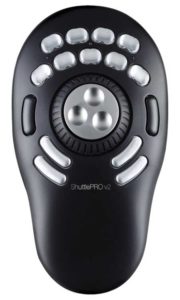 Contour has made the Shuttle Pro for over ten years, and it is compatible with most editing and VFX applications. The Jog Dial is primarily designed to improve navigating through time, helping find or select the exact moment you are looking for in a clip, while the buttons can be programmed for simple or complex operations via their driver utility. I have had one of these for many years, first using it when reframing every shot in Act of Valor at three different aspect ratios. Lot’s of navigation, with small amounts of work. It’s initial appeal was to users moving over from linear editing systems, who were used to navigating content on tapes in a similar fashion. It is still a very effective way of navigating time, but it doesn’t offer much else in the way of controls that couldn’t be replicated with a keyboard.
Contour has made the Shuttle Pro for over ten years, and it is compatible with most editing and VFX applications. The Jog Dial is primarily designed to improve navigating through time, helping find or select the exact moment you are looking for in a clip, while the buttons can be programmed for simple or complex operations via their driver utility. I have had one of these for many years, first using it when reframing every shot in Act of Valor at three different aspect ratios. Lot’s of navigation, with small amounts of work. It’s initial appeal was to users moving over from linear editing systems, who were used to navigating content on tapes in a similar fashion. It is still a very effective way of navigating time, but it doesn’t offer much else in the way of controls that couldn’t be replicated with a keyboard.
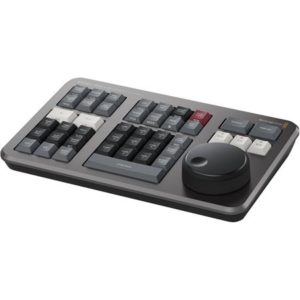 Blackmagic recently developed the Editing Keyboard, and the scaled down version, the Speed Editor, which offer similar jog and shuttle navigation functionality, and a variety of other buttons. These are more editing focused variations of their existing line of interfaces for color correction, which is a task with a longer history of physical interfaces, due to the analog nature of the task. But these devices are limited to use with Resolve, compared to ones from third party vendors that work with many different NLEs.
Blackmagic recently developed the Editing Keyboard, and the scaled down version, the Speed Editor, which offer similar jog and shuttle navigation functionality, and a variety of other buttons. These are more editing focused variations of their existing line of interfaces for color correction, which is a task with a longer history of physical interfaces, due to the analog nature of the task. But these devices are limited to use with Resolve, compared to ones from third party vendors that work with many different NLEs.
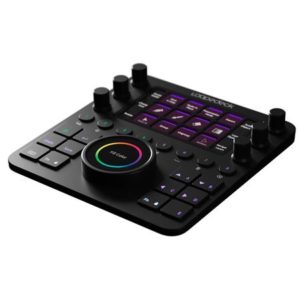 Loupedeck offers two options worth considering for editors, in their Loupedeck+ panel and the newer Loupedeck CT. The CT has the benefit of dynamic LCD labels of what the fewer physical controls are mapped to do, which can be fully customized. But you have to look down to read them and see what page or mode is active. The Loupedeck+ is more tactile in that it has more physical controls, but they aren’t as easy to label or keep track of. It is designed more for analog tasks, like color and sizing adjustments, than for navigating a timeline, although it can do that as well.
Loupedeck offers two options worth considering for editors, in their Loupedeck+ panel and the newer Loupedeck CT. The CT has the benefit of dynamic LCD labels of what the fewer physical controls are mapped to do, which can be fully customized. But you have to look down to read them and see what page or mode is active. The Loupedeck+ is more tactile in that it has more physical controls, but they aren’t as easy to label or keep track of. It is designed more for analog tasks, like color and sizing adjustments, than for navigating a timeline, although it can do that as well.
The best tool is going to depend on your workflow, application, and the way you think. I recommend starting with a high end mouse, and then move on from there once you have effectively memorized the functions that you have mapped there. Physical interfaces are most useful if you can use them without having to think about them. It is going to be harder to adapt to more complex interfaces unless you spend all day doing the same thing. So the wider the variety of tasks you do, the simpler the interface you should try to use.

